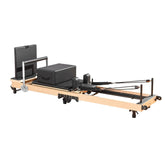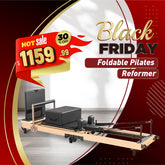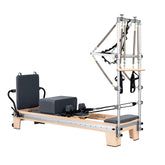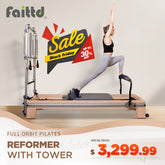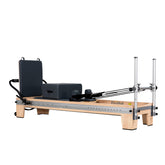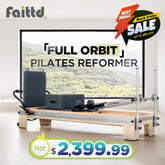Reformer Pilates or Yoga: Find Your Perfect Workout Routine
Key Takeaway:
Reformer Pilates builds core strength using a sliding carriage with springs that create resistance during exercises like "The Hundred" and leg circles. Yoga improves flexibility through static poses such as Downward Dog and Warrior sequences, while incorporating breathing techniques.
Introduction
Torn between signing up for Reformer Pilates or yoga classes? Many people struggle with this choice. Pilates offers machine-based workouts for core strength, while yoga brings flexibility and calm through simple mat poses. This article breaks down both practices to help you find which fits your body and goals best.
Quick Comparison Sheet
| Aspect | Reformer Pilates | Yoga |
| Purpose | Core strength, posture improvement, muscle tone | Flexibility, stress management, spiritual growth |
| History & Origins | Early 20th century by Joseph Pilates | Over 5,000 years old, ancient India |
| Philosophy | Physical focus, biomechanical principles | Holistic approach, integrating mind, body, and spirit |
| Equipment Required | Reformer machine, not typically owned at home | Simple mat, optional blocks and straps |
| Cost per Class | $30-$75 per session | $15-$25 per session, many free online options |
| Space Requirements | Requires large space for reformer | Small space needed for a yoga mat |
| Core Strength | Directly targets core muscles with precision exercises | Develops core strength through integrated poses |
| Flexibility | Builds active flexibility; controlled movements | Enhances passive flexibility; sustained stretches |
| Cardio Benefits | Primarily anaerobic, some cardio with Jumpboard | Vinyasa/Power styles boost heart rate, burns more calories |
| Mental Focus | Requires intense concentration on form and movement | Promotes relaxation, connection through flowing sequences |
| Stress Relief | Temporary relief through focused movement | Utilizes breathing techniques for lasting stress reduction |
| Meditation | No formal meditation | Includes meditation and mindfulness practices |
| Injury Modification | Excellent support and resistance adjustment | Poses adaptable, but require some weight-bearing |
| Beginner Accessibility | Steeper learning curve; initial instruction needed | Many styles accessible to all ages and abilities |
| Calorie Burn | 150-250 calories/hour | 200-400 calories/hour in vigorous styles |
| Suitability for Older Adults | Supports joint health, osteoporosis-friendly | Gentle styles improve joint mobility, suitable for arthritis |
Reformer Pilates
Reformer Pilates is a specialized exercise method performed on a spring-based machine with a sliding carriage designed to build core strength, improve posture, and enhance mind-body connection through controlled movements.
- Classical Reformer follows Joseph Pilates' original sequence of exercises with traditional order and technique.
- Contemporary Reformer incorporates modern fitness science and modifications while maintaining core Pilates principles.
- Clinical Reformer adapts exercises specifically for injury rehabilitation and is often used in physical therapy settings.
- Athletic Reformer increases pace and resistance for enhanced sports performance and more intense conditioning.
- Group Reformer simplifies exercises for multiple participants in a class setting with standardized spring settings.
- HIIT Reformer combines traditional exercises with high-intensity interval training for increased calorie burn.
Yoga
Yoga is an ancient practice that unites physical postures, breathing techniques, and meditation to develop strength, flexibility, balance, and mental clarity while promoting overall wellbeing.
- Hatha Yoga focuses on basic poses held for longer periods, making it ideal for beginners.
- Vinyasa Yoga creates flowing sequences where movement is synchronized with breath for a more dynamic practice.
- Ashtanga Yoga follows a specific sequence of poses performed in the same order each time.
- Bikram Yoga consists of 26 poses performed in a heated room to promote deeper stretching and detoxification.
- Yin Yoga holds passive poses for 3-5 minutes to target deep connective tissues and improve joint flexibility.
- Restorative Yoga uses props to support the body in gentle poses for complete relaxation and stress reduction.
- Kundalini Yoga incorporates chanting, breathing techniques, and specific movements to raise energy awareness.
Different Approaches to Mind and Body: Reformer Pilates vs. Yoga
The philosophical foundations of these practices reveal key differences in their approach:
| Aspect | Yoga's Holistic Philosophy | Reformer Pilates' Physical Focus |
| Integration | Combines physical training with spiritual development | Centers on biomechanical principles and functional movement |
| Ethical Guidelines | Follows yamas and niyamas, such as non-violence and truthfulness | Emphasizes core muscles ("powerhouse") as the foundation for movement |
| Meditation | Uses meditation to achieve mental clarity and inner peace | Prioritizes precision, control, and quality over quantity |
| Body Viewpoint | Views the body as a vessel for spiritual growth | Focuses on alignment and muscle balance for improved performance |

Physical Benefits: How Yoga and Reformer Pilates Shape Your Body
1. Building Strength from the Inside Out
While Reformer Pilates isolates and directly targets deep core muscles through exercises like "The Hundred" with adjustable spring resistance, yoga develops core strength indirectly as part of whole-body integration through poses like Plank and Boat pose.
How Reformer Pilates Works Your Core:
Reformer Pilates directly targets those deep core muscles that many other workouts simply miss. When you perform "The Hundred" exercise lying on the reformer carriage, your transverse abdominis (the deepest abdominal layer) activates to stabilize your torso against the movement. The Footwork series strengthens your pelvic floor while you push against spring resistance with your legs. What makes Pilates especially effective for posture correction is how these precise movements with adjustable resistance create balanced muscle development.
Yoga's Whole-Body Approach to Core:
In yoga, core strength develops naturally as you move through various poses rather than being the primary focus. During Plank pose, your entire abdominal wall engages, but without the targeted precision you'd find in Pilates. When you practice Boat pose (Navasana), balancing on your sit bones while lifting your legs, you work surface abdominal muscles as part of a full-body challenge.
Reformer Pilates focuses on precise, isolated core muscle activation with equipment assistance, whereas yoga builds core strength through stabilizing the body in various positions that engage multiple muscle groups simultaneously.
2. Flexibility That Works in Real Life
Yoga creates passive flexibility through extended holds in positions like Pigeon pose where gravity gradually opens tight tissues, while Reformer Pilates builds active flexibility by strengthening muscles in their extended positions.
Yoga's Deep Stretch Benefits:
Yoga excels at creating passive flexibility where gravity and time do the real work. When you hold Downward Dog, your hamstrings and calves gradually lengthen as you breathe and settle into the pose. The magic of poses like Pigeon happens when you stay there long enough – tight hip muscles and IT bands release with sustained gentle pressure. These stretches, typically held anywhere from 30 seconds to several minutes depending on the style, prove particularly effective for releasing chronically tight muscles and fascia that resist other forms of stretching.
Reformer Pilates for Everyday Movement:
Reformer Pilates develops what trainers call "active flexibility" – the ability to control your body throughout its range of motion. During the Long Stretch series, you strengthen muscles while they're in an extended position, creating useful, functional flexibility. Tower exercises improve shoulder mobility while maintaining core engagement, ensuring you don't just become flexible but also stable.
Where yoga stretches focus on releasing tension through sustained gentle pressure, Reformer Pilates develops functional flexibility by maintaining core engagement during extended positions, ensuring you gain mobility that translates to everyday movements.
3. Getting Your Heart Pumping
Vinyasa and Power yoga provide moderate cardiovascular benefits through continuous flowing movements like Sun Salutations that can burn 200-400 calories per hour, whereas Reformer Pilates offers less cardio intensity at 150-250 calories per hour while focusing on anaerobic strength building.
Yoga as Cardio:
Vinyasa and Power yoga styles can significantly raise your heart rate through continuous, flowing movement. A vigorous series of Sun Salutations will definitely make you sweat as you rapidly transition between poses. A typical Power Yoga class burns between 200-400 calories per hour while simultaneously improving your lung capacity through mindful breathing techniques. For many practitioners, this moderate cardiovascular workout provides an ideal balance of intensity without the high impact of traditional cardio exercises.
Reformer Pilates and Metabolism:
Reformer Pilates functions primarily as an anaerobic exercise that focuses on strength and endurance rather than cardiovascular conditioning. Some sessions incorporate Jumpboard exercises where you push off a vertical board with your feet, providing brief intervals of increased heart rate. While a typical session burns a modest 150-250 calories per hour, the real metabolic benefit comes from building lean muscle mass, which can improve your resting metabolism over time. For pure cardiovascular conditioning, however, Pilates generally proves less effective than more dynamic yoga styles.
Yoga styles with rapid transitions between poses elevate heart rate and improve lung capacity through mindful breathing, but Reformer Pilates primarily builds lean muscle through resistance training with only brief cardio intervals during specific exercises like Jumpboard work.

Mental Benefits: How Yoga and Pilates Affect Your Mind
Yoga and Reformer Pilates don't just work your body—they also help your mind. While both make you feel better mentally, they do this in different ways. Yoga focuses on breathing and meditation to calm you down, while Pilates builds mental strength through focused movements. Here's how they compare:
| Aspect | Yoga | Reformer Pilates |
| Stress Relief | Uses deep breathing techniques to lower stress hormones; yoga practitioners handle stress 30% better | Requires complete focus on movements, helping you forget your worries temporarily |
| Mental Focus | Flowing movements connect mind and body while promoting relaxation | Requires constant attention to form and alignment, improving your body awareness |
| Meditation | Includes quiet meditation time, often ending with lying still for deep relaxation | No formal meditation, but the intense concentration creates a meditative effect |
| Brain Benefits | Teaches you to stay present and accept feelings without judgment | Improves mental function through complex movements that require coordination |
| Emotional Health | Builds skills that help manage everyday stress and control impulses | Develops mental toughness as you master challenging movements |
| Long-term Effects | Helps improve sleep, reduce depression, and manage emotions better | Increases confidence, improves focus, and builds belief in your abilities |
Over time, both practices change how you handle stress in your daily life. People who do yoga regularly often stay calmer during difficult situations. Those who practice Pilates frequently notice they're more aware of their posture and movement throughout the day.
Space, Cost and Equipment for Yoga and Pilates
The physical and mental benefits of yoga and Pilates are great, but let's talk about the practical side—cost, equipment, and whether you can actually do them at home.
| Aspect | Yoga | Reformer Pilates |
| Basic Equipment | Simple mat ($20-80), optional blocks and straps ($10-30) | Requires access to a reformer machine, rarely owned at home |
| Cost of Classes | $15-25 for group classes; many free online options available | $30-75 per session; group classes slightly cheaper but still premium-priced |
| Home Practice | Easily done in small spaces with minimal equipment | Nearly impossible without purchasing a reformer ($2,500-4,000 for quality machines) |
| Space Requirements | Just enough room for a yoga mat (about 6 × 2 feet) | Reformer machines need dedicated space (7 × 2.5 feet minimum) |
| Workout Clothes | Comfortable, stretchy clothing; can be practiced barefoot | Similar to yoga, though socks are often required in studios |
| Injury Modification | Poses can be adapted but still require some weight-bearing | Excellent for injuries; reformer supports body weight and provides adjustable resistance |
| Physical Limitations | Can be challenging for those with balance issues or limited mobility | Carriage provides stability and support; springs can be adjusted for all strength levels |
| Beginner Accessibility | Many styles and levels available; gentle options for all ages | Steeper learning curve; requires initial instruction for proper form |
Yoga's accessibility makes it easy to maintain a consistent practice anywhere, anytime. You can roll out a mat in a hotel room, follow along with a free YouTube video, and get a complete workout. Reformer Pilates, while more equipment-dependent than yoga, offers unique advantages for people recovering from injuries or managing chronic pain. The reformer's carriage supports your body while the springs provide gentle resistance, making it possible to strengthen muscles without putting pressure on sensitive joints or the spine. This makes it particularly valuable for rehabilitation, though the cost and need for specialized equipment means you'll likely need to visit a studio rather than practice at home.
Reformer Pilates vs. Yoga: Which Practice Is Right for You?
Choosing between yoga and Reformer Pilates doesn't have to be complicated. Your personal goals and preferences can guide you to the right practice. Below is a simple framework to help you decide which might work best for your needs.
When Reformer Pilates Might Be Better For You
Reformer Pilates could be your ideal choice if you're looking to:
- Strengthen your core and improve posture
- Recover from an injury, especially back problems
- Build balanced muscle tone without bulking up
- Get clear, measurable results from structured workouts
Many people find Reformer Pilates particularly effective for addressing specific physical issues. In fact, a recent clinical study showed impressive results—people with chronic lower back pain saw a 47% reduction in pain after just 8 weeks of regular Reformer Pilates sessions.
When Yoga Might Suit You Better
Yoga might be the better fit if your priorities include:
- Increasing overall flexibility and range of motion
- Finding effective ways to manage stress and anxiety
- Exploring mindfulness and meditation
- Enjoying varied classes from gentle to challenging
Yoga's benefits for mental wellbeing are well-documented. One study found that people with sleep problems who practiced yoga regularly experienced 35% better sleep quality. Many practitioners also value yoga's spiritual dimension and the way it creates a sense of community.
Considering Both Options
You don't necessarily have to choose just one practice. Many fitness enthusiasts are discovering the benefits of combining both approaches:
- About 35% of fitness studios now offer fusion classes like "Yogalates" that blend elements from both practices
- These hybrid classes typically combine yoga's flowing stretches with Pilates' targeted core exercises
- This combined approach works well for busy people who want comprehensive fitness in a single session
- You might practice yoga at home for daily flexibility and stress relief, then attend Reformer Pilates sessions weekly for targeted strength work

Frequently Asked Questions: Yoga vs. Reformer Pilates
Q1: Which Burns More Calories?
Yoga burns more calories than Reformer Pilates—about 200-400 calories per hour to 150-250 for Pilates. Neither exercise, however, is suitable for weight loss by itself. To achieve maximum results, combine either exercise with regular cardio exercise like walking, swimming, or cycling.
Q2: Can Reformer Pilates Replace Physical Therapy?
No, reformer Pilates should not be used as an absolute replacement for physical therapy. In fact, some physical therapists include Reformer Pilates as part of a rehabilitation program. It is aptly suited for regaining strength safely because it provides controlled resistance and is sensitive to proper alignment. However, take it first under the care of your medical provider.
Q3: Which Is Better For Older Adults?
Both exercises can be modified for older adults, but they have different advantages:
- Reformer Pilates is more accommodating for osteoporosis patients since the machine supports body weight and reduces the risk of fracture. The controlled movement is less stressful on older joints without compromising the strength that must be achieved.
- Gentle yoga styles like Chair Yoga are particularly helpful for arthritis sufferers, improving joint mobility without putting pressure on painful areas. Many senior centers offer specialized yoga classes designed specifically for older adults.
Q4: Do I Need To Be Flexible To Start Yoga?
No—this is a common myth. Yoga is not about being flexible but starting not to be flexible. Beginner classes have modifications for each pose, and the use of blocks and straps helps to make poses accessible to all. Your flexibility will build up over time with practice.
Q5: How Many Sessions Before Seeing Results?
Most people see some changes after 4-6 practice sessions. In Reformer Pilates, most will notice the change in posture and core strength first. With yoga, increased flexibility and decreased stress tend to be the first signs. Greater physical change usually manifests around 8-12 weeks of regular practice (2-3 times a week).
Q6: Can I Do Both Yoga and Reformer Pilates In The Same Week?
Absolutely! Both practices are recommended by most fitness experts to be practiced together for overall gain. Practice yoga on days when you need stress release and stretching, and Reformer Pilates on days when you want core building and posture. Just ensure you give your body enough rest in between rigorous practice.
